Abstract
Several characteristics of normal renal function increase the risk to the kidney of damage by environmental toxins. Due to the magnitude of renal blood flow the total amount of noxious substance delivered may be disproportionately high. Furthermore, the capacity to concentrate substances within the kidney by processes of filtration, reabsorption and secretion has the potential to increase the toxicity of agents which would otherwise not lead to tissue injury. Unfortunately, there are few tests of renal function which are able to detect early functional abnormalities and which, at the same time, are suited for screening purposes by virtue of their simplicity, cost and safety. Furthermore, interpretation of the tests is complicated by adaptive changes in renal function which occur with aging and in response to other disease processes.
Environmental agents produce a wide spectrum of renal dysfunction. Acute renal damage follows exposure to glycols, organic solvents, heavy metals, diagnostic and therapeutic agents and a variety of miscellaneous substances. Chronic renal disease may take the form of isolated tubular defects as seen with cadmium, interstitial nephritis due to the ingestion of lead, or vascular damage induced by external radiation. Some forms of glomerulonephritis may also be related to environmental toxins as are certain tumors of the urinary tract.
In a somewhat different fashion, patients whose renal function is limited by the presence of pre-existing disease may manifest toxicity from substances ordinarily excreted in the urine. Particular problems exist with the patients on dialysis, as they are at considerable risk to alterations in the environment.
Full text
PDF
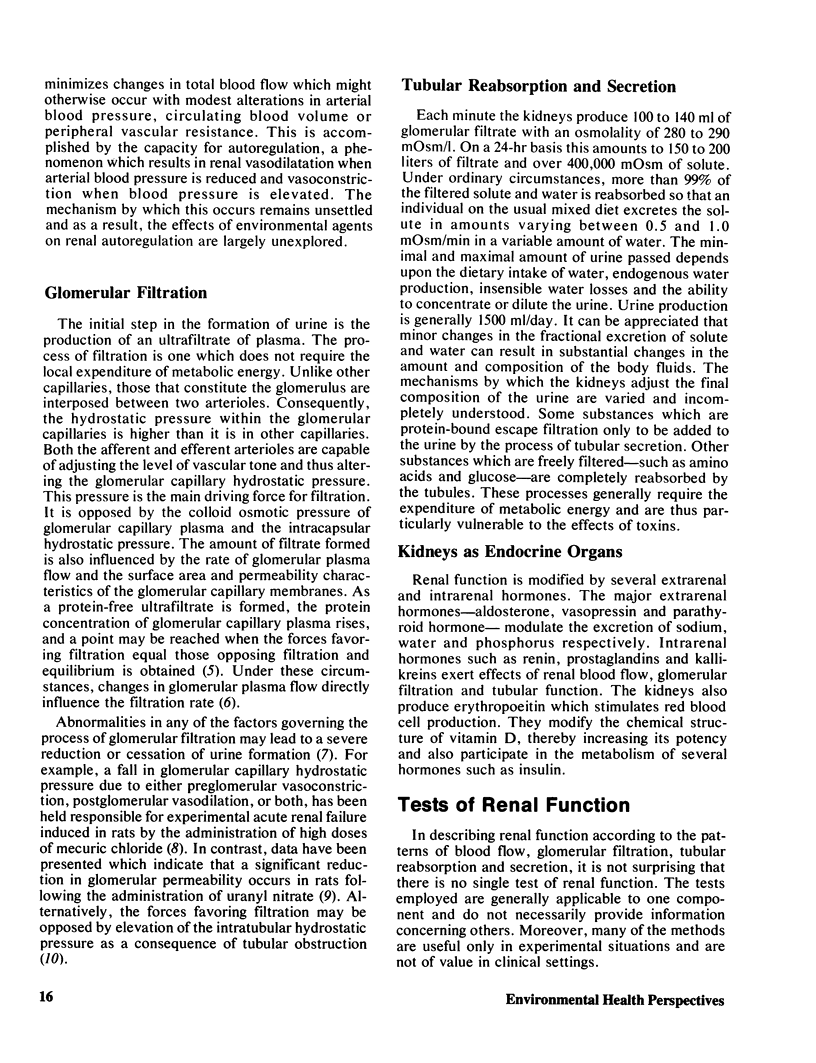
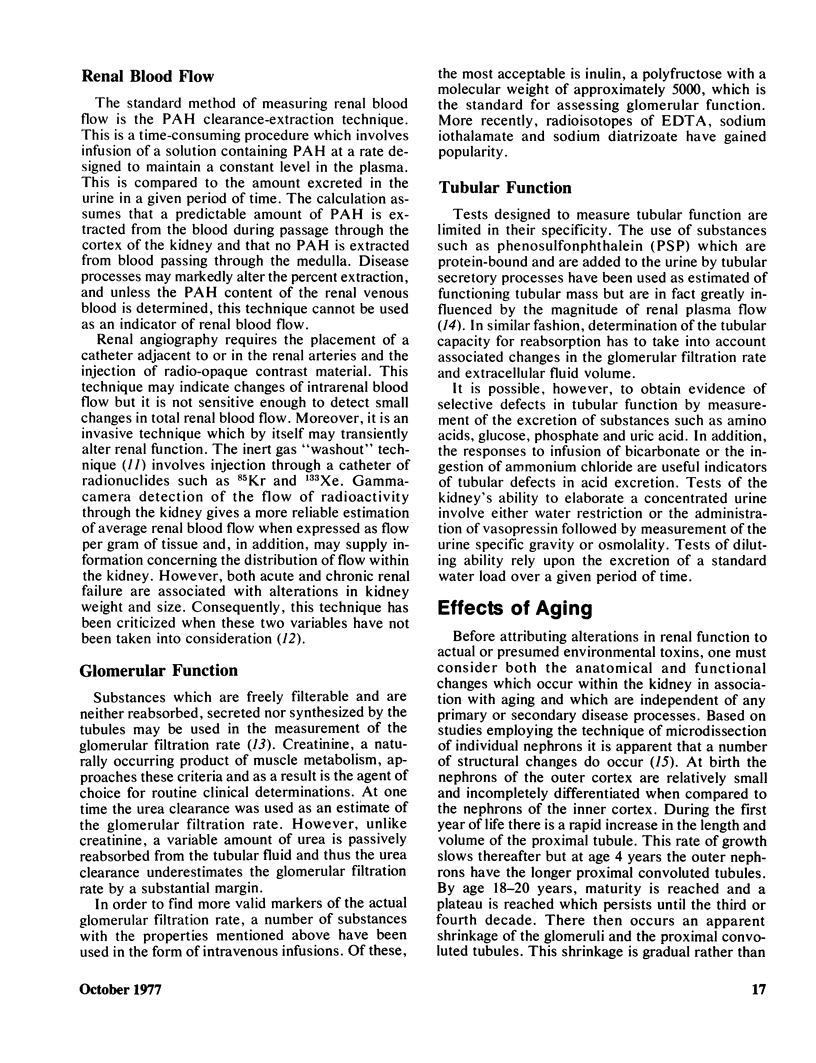

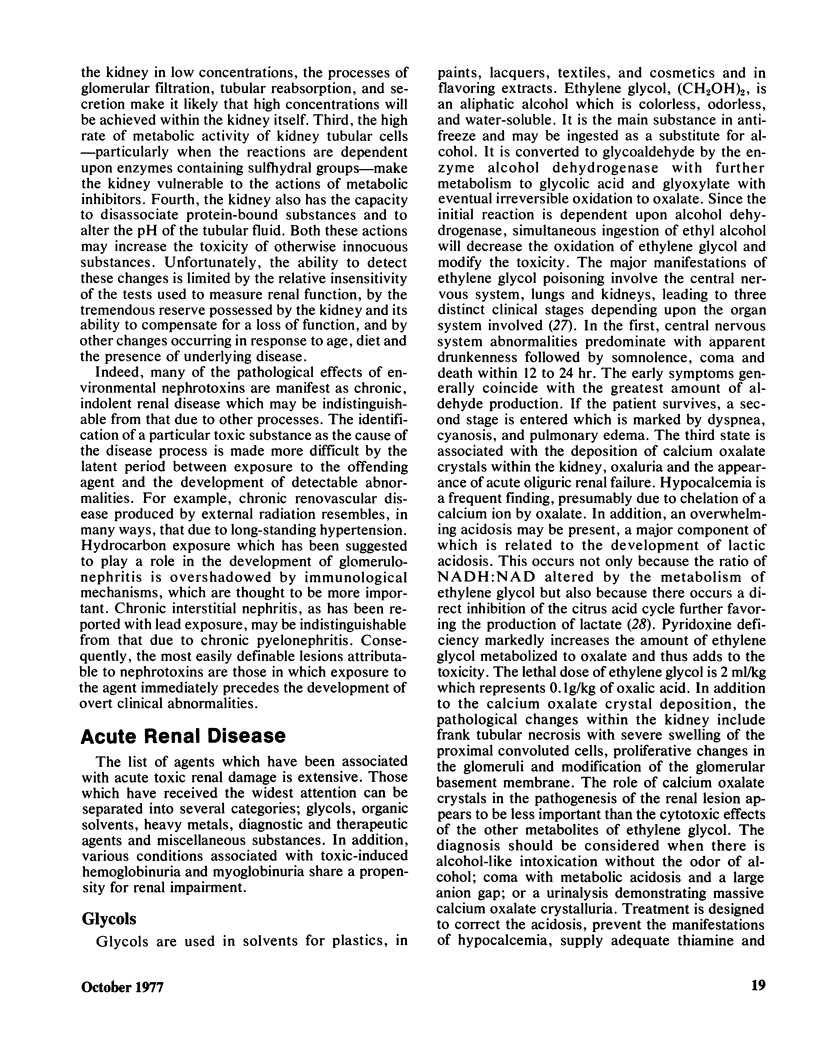
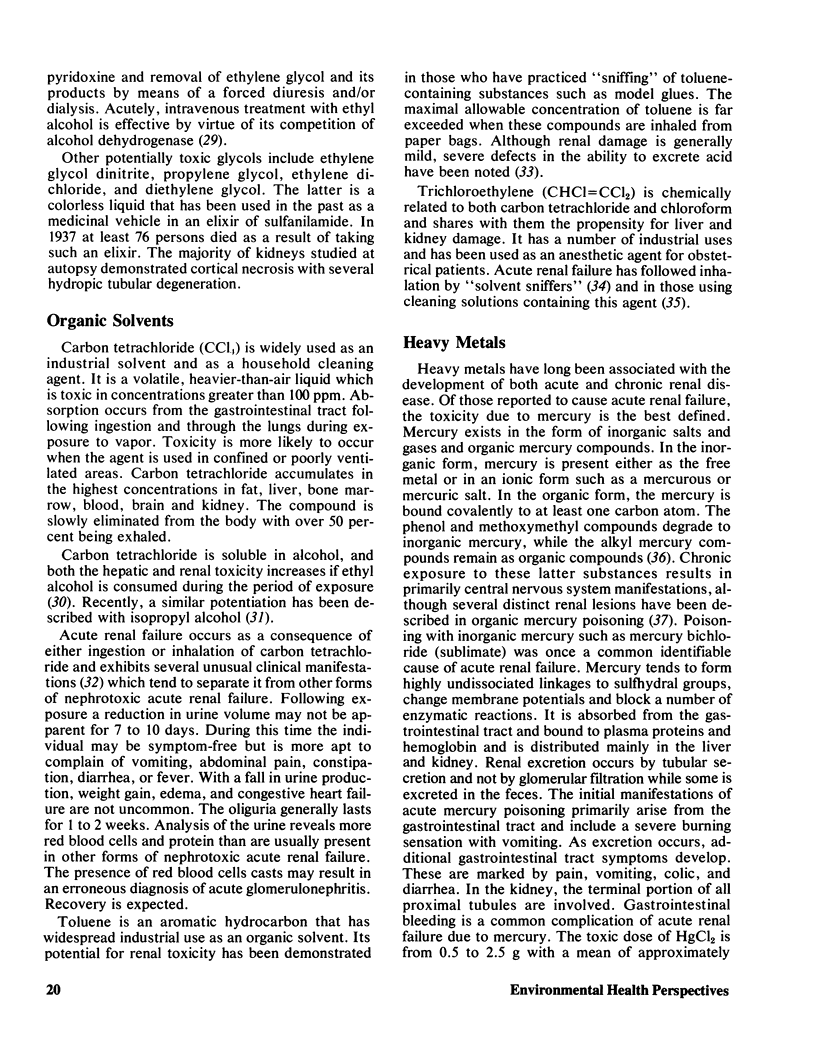

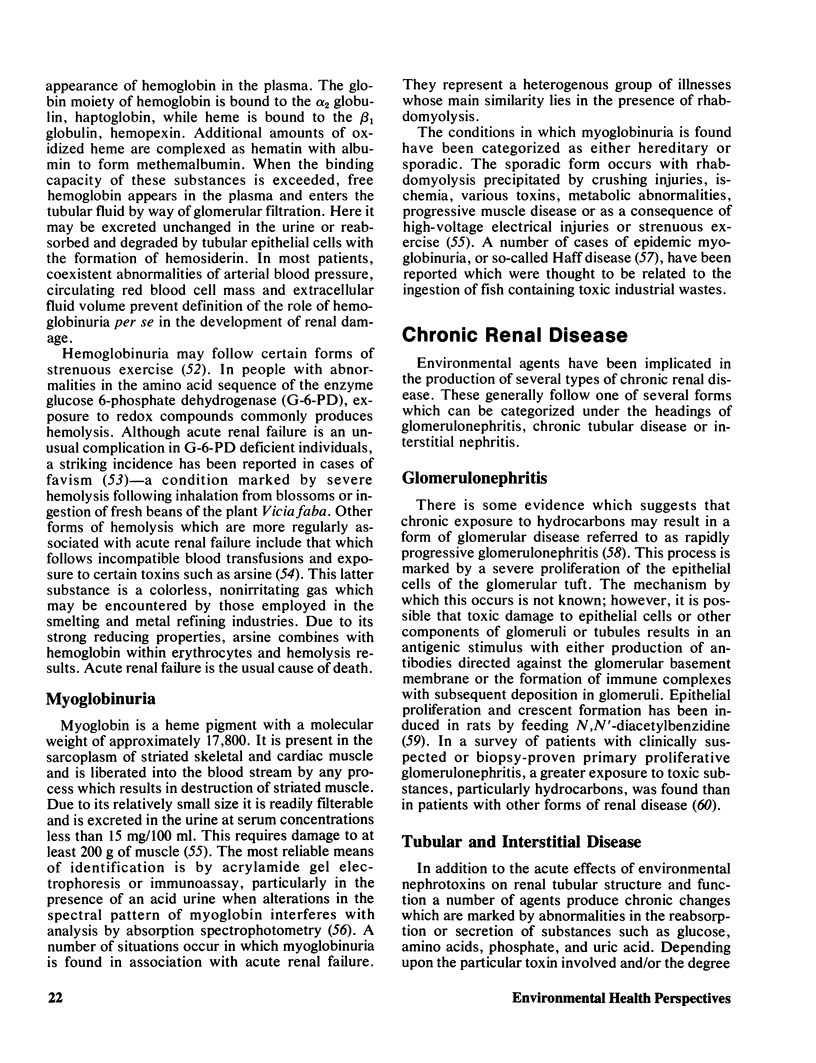
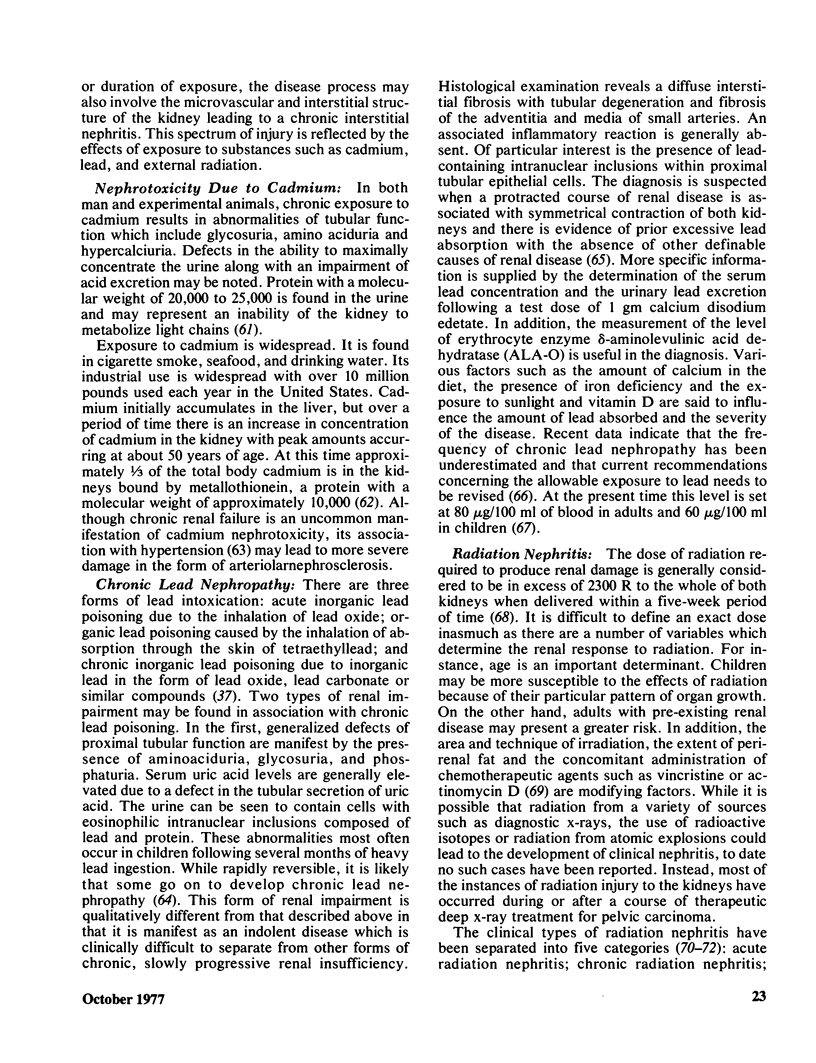
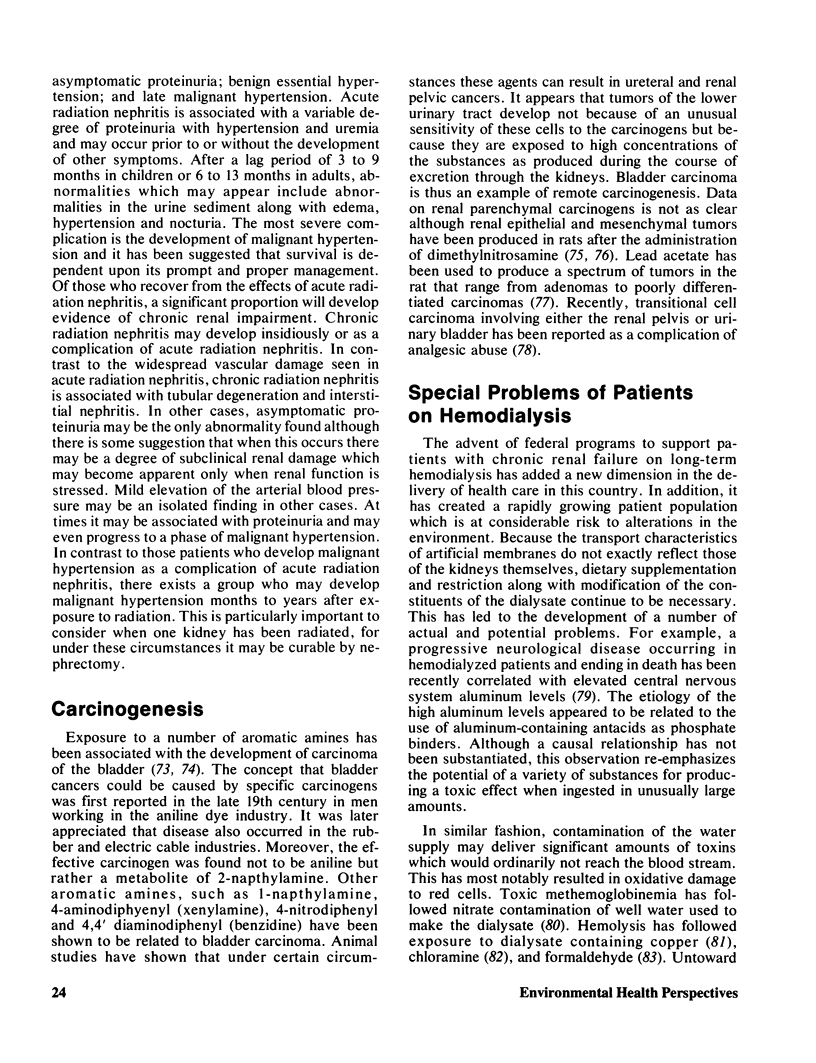
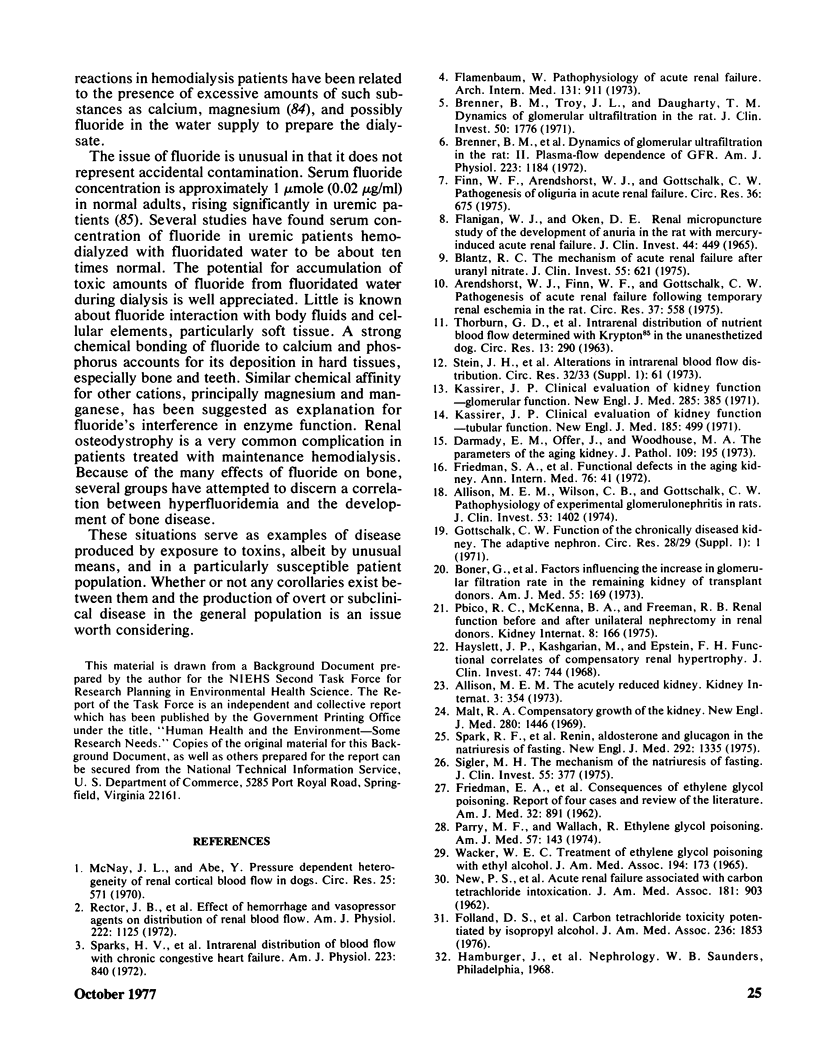

Selected References
These references are in PubMed. This may not be the complete list of references from this article.
- Alfrey A. C., LeGendre G. R., Kaehny W. D. The dialysis encephalopathy syndrome. Possible aluminum intoxication. N Engl J Med. 1976 Jan 22;294(4):184–188. doi: 10.1056/NEJM197601222940402. [DOI] [PubMed] [Google Scholar]
- Allison M. E., Lipham E. M., Lassiter W. E., Gottschalk C. W. The acutely reduced kidney. Kidney Int. 1973 Jun;3(6):354–363. doi: 10.1038/ki.1973.57. [DOI] [PubMed] [Google Scholar]
- Allison M. E., Wilson C. B., Gottschalk C. W. Pathophysiology of experimental glomerulonephritis in rats. J Clin Invest. 1974 May;53(5):1402–1423. doi: 10.1172/JCI107689. [DOI] [PMC free article] [PubMed] [Google Scholar]
- Appel G. B., Neu H. C. The nephrotoxicity of antimicrobial agents (third of three parts). N Engl J Med. 1977 Apr 7;296(14):784–787. doi: 10.1056/NEJM197704072961404. [DOI] [PubMed] [Google Scholar]
- Arendshorst W. J., Finn W. F., Gottschalk C. W. Pathogenesis of acute renal failure following temporary renal ischemia in the rat. Circ Res. 1975 Nov;37(5):558–568. doi: 10.1161/01.res.37.5.558. [DOI] [PubMed] [Google Scholar]
- Arneil G. C., Harris F., Emmanuel I. G., Young D. G., Flatman G. E., Zachary R. B. Nephritis in two children after irradiation and chemotherapy for nephroblastoma. Lancet. 1974 May 18;1(7864):960–963. doi: 10.1016/s0140-6736(74)91264-1. [DOI] [PubMed] [Google Scholar]
- Baerg R. D., Kimberg D. V. Centrilobular hepatic necrosis and acute renal failure in "solvent sniffers". Ann Intern Med. 1970 Nov;73(5):713–720. doi: 10.7326/0003-4819-73-5-713. [DOI] [PubMed] [Google Scholar]
- Beirne G. J., Brennan J. T. Glomerulonephritis associated with hydrocarbon solvents: mediated by antiglomerular basement membrane antibody. Arch Environ Health. 1972 Nov;25(5):365–369. doi: 10.1080/00039896.1972.10666187. [DOI] [PubMed] [Google Scholar]
- Bergman L. A., Ellison M. R., Dunea G. Acute renal failure after drip-infusion pyelography. N Engl J Med. 1968 Dec 5;279(23):1277–1277. doi: 10.1056/NEJM196812052792308. [DOI] [PubMed] [Google Scholar]
- Blantz R. C. The mechanism of acute renal failure after uranyl nitrate. J Clin Invest. 1975 Mar;55(3):621–635. doi: 10.1172/JCI107970. [DOI] [PMC free article] [PubMed] [Google Scholar]
- Boner G., Shelp W. D., Newton M., Rieselbach R. E. Factors influencing the increase in glomerular filtration rate in the remaining kidney of transplant donors. Am J Med. 1973 Aug;55(2):169–174. doi: 10.1016/0002-9343(73)90165-4. [DOI] [PubMed] [Google Scholar]
- Brenner B. M., Troy J. L., Daugharty T. M., Deen W. M., Robertson C. R. Dynamics of glomerular ultrafiltration in the rat. II. Plasma-flow dependence of GFR. Am J Physiol. 1972 Nov;223(5):1184–1190. doi: 10.1152/ajplegacy.1972.223.5.1184. [DOI] [PubMed] [Google Scholar]
- Brenner B. M., Troy J. L., Daugharty T. M. The dynamics of glomerular ultrafiltration in the rat. J Clin Invest. 1971 Aug;50(8):1776–1780. doi: 10.1172/JCI106667. [DOI] [PMC free article] [PubMed] [Google Scholar]
- Canales C. O., Smith G. H., Robinson J. C., Remmers A. R., Jr, Sarles H. E. Brief recordings. Acute renal failure after the administration of iopanoic acid as a cholecystographic agent. N Engl J Med. 1969 Jul 10;281(2):89–91. doi: 10.1056/NEJM196907102810207. [DOI] [PubMed] [Google Scholar]
- Carlson D. J., Shapiro F. L. Methemoglobinemia from well water nitrates: a complication of home dialysis. Ann Intern Med. 1970 Nov;73(5):757–759. doi: 10.7326/0003-4819-73-5-757. [DOI] [PubMed] [Google Scholar]
- Darmady E. M., Offer J., Woodhouse M. A. The parameters of the ageing kidney. J Pathol. 1973 Mar;109(3):195–207. doi: 10.1002/path.1711090304. [DOI] [PubMed] [Google Scholar]
- Diaz-Buxo J. A., Wagoner R. D., Hattery R. R., Palumbo P. J. Acute renal failure after excretory urography in diabetic patients. Ann Intern Med. 1975 Aug;83(2):155–158. doi: 10.7326/0003-4819-83-2-155. [DOI] [PubMed] [Google Scholar]
- Eaton J. W., Kolpin C. F., Swofford H. S., Kjellstrand C. M., Jacob H. S. Chlorinated urban water: a cause of dialysis-induced hemolytic anemia. Science. 1973 Aug 3;181(4098):463–464. doi: 10.1126/science.181.4098.463. [DOI] [PubMed] [Google Scholar]
- Emmerson B. T. Chronic lead nephropathy. Kidney Int. 1973 Jul;4(1):1–5. doi: 10.1038/ki.1973.73. [DOI] [PubMed] [Google Scholar]
- FLANIGAN W. J., OKEN D. E. RENAL MICROPUNCTURE STUDY OF THE DEVELOPMENT OF ANURIA IN THE RAT WITH MERCURY-INDUCED ACUTE RENAL FAILURE. J Clin Invest. 1965 Mar;44:449–457. doi: 10.1172/JCI105158. [DOI] [PMC free article] [PubMed] [Google Scholar]
- FRIEDMAN E. A., GREENBERG J. B., MERRILL J. P., DAMMIN G. J. Consequences of ethylene glycol poisoning. Report of four cases and review of the literature. Am J Med. 1962 Jun;32:891–902. doi: 10.1016/0002-9343(62)90035-9. [DOI] [PubMed] [Google Scholar]
- Fairshter R. D., Wilson A. F. Paraquat poisoning: manifestations and therapy. Am J Med. 1975 Dec;59(6):751–753. doi: 10.1016/0002-9343(75)90459-3. [DOI] [PubMed] [Google Scholar]
- Finn W. F., Arendshorst W. J., Gottschalk C. W. Pathogenesis of oliguria in acute renal failure. Circ Res. 1975 Jun;36(6):675–681. doi: 10.1161/01.res.36.6.675. [DOI] [PubMed] [Google Scholar]
- Fisher H. K., Humphries M., Bails R. Paraquat poisoning. Recovery from renal and pulmonary damage. Ann Intern Med. 1971 Nov;75(5):731–736. doi: 10.7326/0003-4819-75-5-731. [DOI] [PubMed] [Google Scholar]
- Flamenbaum W. Pathophysiology of acute renal failure. Arch Intern Med. 1973 Jun;131(6):911–928. [PubMed] [Google Scholar]
- Flick D. F., Kraybill H. F., Dimitroff J. M. Toxic effects of cadmium: a review. Environ Res. 1971 Apr;4(2):71–85. doi: 10.1016/0013-9351(71)90036-3. [DOI] [PubMed] [Google Scholar]
- Folland D. S., Schaffner W., Ginn H. E., Crofford O. B., McMurray D. R. Carbon tetrachloride toxicity potentiated by isopropyl alcohol. Investigation of an industrial outbreak. JAMA. 1976 Oct 18;236(16):1853–1856. [PubMed] [Google Scholar]
- Fowler B. A., Weissberg J. B. Arsine poisoning. N Engl J Med. 1974 Nov 28;291(22):1171–1174. doi: 10.1056/NEJM197411282912207. [DOI] [PubMed] [Google Scholar]
- Freeman R. M., Lawton R. L., Chamberlain M. A. Hard-water syndrome. N Engl J Med. 1967 May 18;276(20):1113–1118. doi: 10.1056/NEJM196705182762003. [DOI] [PubMed] [Google Scholar]
- Friedman S. A., Raizner A. E., Rosen H., Solomon N. A., Sy W. Functional defects in the aging kidney. Ann Intern Med. 1972 Jan;76(1):41–45. doi: 10.7326/0003-4819-76-1-41. [DOI] [PubMed] [Google Scholar]
- GUTCH C. F., TOMHAVE W. G., STEVENS S. C. ACUTE RENAL FAILURE DUE TO INHALATION OF TRICHLORETHYLENE. Ann Intern Med. 1965 Jul;63:128–134. doi: 10.7326/0003-4819-63-1-128. [DOI] [PubMed] [Google Scholar]
- Grossman R. A., Hamilton R. W., Morse B. M., Penn A. S., Goldberg M. Nontraumatic rhabdomyolysis and acute renal failure. N Engl J Med. 1974 Oct 17;291(16):807–811. doi: 10.1056/NEJM197410172911601. [DOI] [PubMed] [Google Scholar]
- Harman J. W. Chronic glomerulonephritis and the nephrotic syndrome induced in rats with N,N'-diacetylbenzidine. J Pathol. 1971 Jun;104(2):119–128. doi: 10.1002/path.1711040206. [DOI] [PubMed] [Google Scholar]
- Heavy metal poisoning: mercury and lead. Ann Intern Med. 1972 May;76(5):779–792. doi: 10.7326/0003-4819-76-5-779. [DOI] [PubMed] [Google Scholar]
- Ireton H. J., McGiven A. R., Davies D. J. Renal mesenchymal tumours induced in rats by dimethylnitrosamine: light- and electron-microscope studies. J Pathol. 1972 Nov;108(3):181–185. doi: 10.1002/path.1711080302. [DOI] [PubMed] [Google Scholar]
- Joselow M. M., Louria D. B., Browder A. A. Mercurialism: environmental and occupational aspects. Ann Intern Med. 1972 Jan;76(1):119–130. doi: 10.7326/0003-4819-76-1-119. [DOI] [PubMed] [Google Scholar]
- Kassirer J. P. Clinical evaluation of kidney function--glomerular function. N Engl J Med. 1971 Aug 12;285(7):385–389. doi: 10.1056/NEJM197108122850706. [DOI] [PubMed] [Google Scholar]
- Kassirer J. P. Clinical evaluation of kidney function--tubular function. N Engl J Med. 1971 Aug 26;285(9):499–502. doi: 10.1056/NEJM197108262850906. [DOI] [PubMed] [Google Scholar]
- Klein W. J., Jr, Metz E. N., Price A. R. Acute copper intoxication. A hazard of hemodialysis. Arch Intern Med. 1972 Apr;129(4):578–582. [PubMed] [Google Scholar]
- LUXTON R. W. Radiation nephritis. A long-term study of 54 patients. Lancet. 1961 Dec 2;2(7214):1221–1224. doi: 10.1016/s0140-6736(61)92590-9. [DOI] [PubMed] [Google Scholar]
- Lin-Fu J. S. Undue absorption of lead among children--a new look at an old problem. N Engl J Med. 1972 Mar 30;286(13):702–710. doi: 10.1056/NEJM197203302861306. [DOI] [PubMed] [Google Scholar]
- Liu T., Smith G. W., Rankin J. T. Renal pelvic tumour associated with analgesic abuse. Can Med Assoc J. 1972 Oct 21;107(8):768–passim. [PMC free article] [PubMed] [Google Scholar]
- Louria D. B., Joselow M. M., Browder A. A. The human toxicity of certain trace elements. Ann Intern Med. 1972 Feb;76(2):307–319. doi: 10.7326/0003-4819-76-2-307. [DOI] [PubMed] [Google Scholar]
- MELLINS R. B., JENKINS C. D. Epidemiological and psychological study of lead poisoning in children. J Am Med Assoc. 1955 May 7;158(1):15–20. doi: 10.1001/jama.1955.02960010017004. [DOI] [PubMed] [Google Scholar]
- Madrazo A., Schwarz G., Churg J. Radiation nephritis: a review. J Urol. 1975 Dec;114(6):822–827. doi: 10.1016/s0022-5347(17)67152-0. [DOI] [PubMed] [Google Scholar]
- Malt R. A. Compensatory growth of the kidney. N Engl J Med. 1969 Jun 26;280(26):1446–1459. doi: 10.1056/NEJM196906262802606. [DOI] [PubMed] [Google Scholar]
- Mao P., Molnar J. J. The fine structure and histochemistry of lean-induced renal tumors in rats. Am J Pathol. 1967 Apr;50(4):571–603. [PMC free article] [PubMed] [Google Scholar]
- McGiven A. R., Ireton H. J. Renal epithelial dysplasia and neoplasia in rats given dimethylnitrosamine. J Pathol. 1972 Nov;108(3):187–190. doi: 10.1002/path.1711080303. [DOI] [PubMed] [Google Scholar]
- McNay J. L., Abe Y. Pressure-dependent heterogeneity of renal cortical blood flow in dogs. Circ Res. 1970 Oct;27(4):571–587. doi: 10.1161/01.res.27.4.571. [DOI] [PubMed] [Google Scholar]
- Moreau J. F., Droz D., Sabto J., Jungers P., Kleinknecht D., Hinglais N., Michel J. R. Osmotic Nephrosis Induced by Water-Soluble Triiodinated Contrast Media in Man. A Retrospective Study of 47 Cases. Radiology. 1975 May;115(2):329–336. doi: 10.1148/115.2.329. [DOI] [PubMed] [Google Scholar]
- Morgan J. M., Hartley M. W., Miller R. E. Nephropathy in chronic lead poisoning. Arch Intern Med. 1966 Jul;118(1):17–29. [PubMed] [Google Scholar]
- NEW P. S., LUBASH G. D., SCHERR L., RUBIN A. L. Acute renal failure associated with carbon tetrachloride intoxication. JAMA. 1962 Sep 8;181:903–906. doi: 10.1001/jama.1962.03050360089019c. [DOI] [PubMed] [Google Scholar]
- Namba T., Nolte C. T., Jackrel J., Grob D. Poisoning due to organophosphate insecticides. Acute and chronic manifestations. Am J Med. 1971 Apr;50(4):475–492. doi: 10.1016/0002-9343(71)90337-8. [DOI] [PubMed] [Google Scholar]
- Norby L. H., DiBona G. F. The renal vascular effects of meglumine diatrizoate. J Pharmacol Exp Ther. 1975 Jun;193(3):932–940. [PubMed] [Google Scholar]
- Orringer E. P., Mattern W. D. Formaldehyde-induced hemolysis during chronic hemodialysis. N Engl J Med. 1976 Jun 24;294(26):1416–1420. doi: 10.1056/NEJM197606242942602. [DOI] [PubMed] [Google Scholar]
- Parry M. F., Wallach R. Ethylene glycol poisoning. Am J Med. 1974 Jul;57(1):143–150. doi: 10.1016/0002-9343(74)90780-3. [DOI] [PubMed] [Google Scholar]
- Perry H. M., Jr, Thind G. S., Perry E. F. The biology of cadmium. Med Clin North Am. 1976 Jul;60(4):759–769. doi: 10.1016/s0025-7125(16)31859-4. [DOI] [PubMed] [Google Scholar]
- Pollard T. D., Weiss I. W. Acute tubular necrosis in a patient with march hemoglobinuria. N Engl J Med. 1970 Oct 8;283(15):803–804. doi: 10.1056/NEJM197010082831509. [DOI] [PubMed] [Google Scholar]
- Port F. K., Wagoner R. D., Fulton R. E. Acute renal failure after angiography. Am J Roentgenol Radium Ther Nucl Med. 1974 Jul;121(3):544–550. doi: 10.2214/ajr.121.3.544. [DOI] [PubMed] [Google Scholar]
- Prout G. R., Jr Bladder carcinoma. N Engl J Med. 1972 Jul 13;287(2):86–90. doi: 10.1056/NEJM197207132870207. [DOI] [PubMed] [Google Scholar]
- RENE R. M., MELLINKOFF S. M. Renal insufficiency after oral administration of a double dose of a cholecystographic medium: report of two cases. N Engl J Med. 1959 Sep 17;261:589–592. doi: 10.1056/NEJM195909172611204. [DOI] [PubMed] [Google Scholar]
- Rector J. B., Stein J. H., Bay W. H., Osgood R. W., Ferris T. F. Effect of hemorrhage and vasopressor agents on distribution of renal blood flow. Am J Physiol. 1972 May;222(5):1125–1131. doi: 10.1152/ajplegacy.1972.222.5.1125. [DOI] [PubMed] [Google Scholar]
- Rowland L. P., Penn A. S. Myoglobinuria. Med Clin North Am. 1972 Nov;56(6):1233–1256. doi: 10.1016/s0025-7125(16)32319-7. [DOI] [PubMed] [Google Scholar]
- Sigler M. H. The mechanism of the natriuresis of fasting. J Clin Invest. 1975 Feb;55(2):377–387. doi: 10.1172/JCI107941. [DOI] [PMC free article] [PubMed] [Google Scholar]
- Spark R. F., Arky R. A., Boulter P. R., Saudek C. D., O'Brian J. T. Renin, aldosterone and glucagon in the natriuresis of fasting. N Engl J Med. 1975 Jun 19;292(25):1335–1340. doi: 10.1056/NEJM197506192922506. [DOI] [PubMed] [Google Scholar]
- Sparks H. V., Kopald H. H., Carrière S., Chimoskey J. E., Kinoshita M., Barger A. C. Intrarenal distribution of blood flow with chronic congestive heart failure. Am J Physiol. 1972 Oct;223(4):840–846. doi: 10.1152/ajplegacy.1972.223.4.840. [DOI] [PubMed] [Google Scholar]
- Symvoulidis A., Voudiclaris S., Mountokalakis T., Pougounias H. Acute renal failure in G.-6-P.D. Lancet. 1972 Oct 14;2(7781):819–820. [PubMed] [Google Scholar]
- THORBURN G. D., KOPALD H. H., HERD J. A., HOLLENBERG M., O'MORCHOE C. C., BARGER A. C. INTRARENAL DISTRIBUTION OF NUTRIENT BLOOD FLOW DETERMINED WITH KRYPTON 85 IN THE UNANESTHETIZED DOG. Circ Res. 1963 Oct;13:290–307. doi: 10.1161/01.res.13.4.290. [DOI] [PubMed] [Google Scholar]
- Wands J. R., Weiss S. W., Yardley J. H., Maddrey W. C. Chronic inorganic mercury poisoning due to laxative abuse. A clinical and ultrastructural study. Am J Med. 1974 Jul;57(1):92–101. doi: 10.1016/0002-9343(74)90773-6. [DOI] [PubMed] [Google Scholar]
- Wedeen R. P., Maesaka J. K., Weiner B., Lipat G. A., Lyons M. M., Vitale L. F., Joselow M. M. Occupational lead nephropathy. Am J Med. 1975 Nov;59(5):630–641. doi: 10.1016/0002-9343(75)90224-7. [DOI] [PubMed] [Google Scholar]
- Wyckoff D. W., Davies J. E., Barquet A., Davis J. H. Diagnostic and therapeutic problems of parathion poisonings. Ann Intern Med. 1968 Apr;68(4):875–882. doi: 10.7326/0003-4819-68-4-875. [DOI] [PubMed] [Google Scholar]
- Zimmerman S. W., Groehler K., Beirne G. J. Hydrocarbon exposure and chronic glomerulonephritis. Lancet. 1975 Aug 2;2(7927):199–201. doi: 10.1016/s0140-6736(75)90671-6. [DOI] [PubMed] [Google Scholar]


